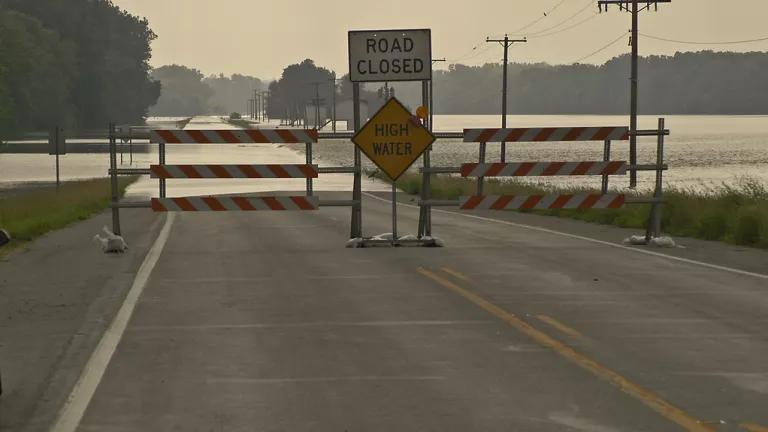
The climate is changing. Extreme storms and flooding are becoming more common - especially in the Midwest and Northeast. That is because warmer air and water temperatures exacerbate the frequency and severity of extreme weather events. For coastal areas, there is the added spectre of sea level rise. As the sea rises, smaller hurricanes and tropical storms will be capable of delivering more damaging blows to the cities, towns, and local communities that dot our shorelines.
Reducing the amount of greenhouse gases spewing into the atmosphere is the most obvious solution for addressing the projected impacts of climate change. As a society, we have a responsibility to future generations to mitigate to the best of our ability the rate at which the climate is changing by implementing policies like the Clean Power Plan. The plan will move America toward a cleaner, healthier environment for future generations by reducing our carbon pollution.
While actions, like the Clean Power Plan, will help stabilize the rate at which our climate is changing, and will help prevent the most catastrophic climate change scenarios from occurring, it will not address the level of CO2 that is already in our atmosphere from over 150 years of industrialization. The amount of CO2 currently in the atmosphere, around 400 ppm, will have an impact on the climate and for that we need to be prepared.
We can prepare by making our communities more resilient to climate change. And the Federal Emergency Management Agency has taken a step in the right direction by now requiring that states consider the projected effects of climate change in their State Hazard Mitigation Plans. Under the new guidance, in order for a state's plan to be approved by FEMA, thereby making the state eligible to receive federal funding for pre-disaster mitigation projects designed to build resilience, it must "include considerations of changing future conditions, including the effects of long-term changes in weather patterns and climate on the identified hazards."
The importance of this new requirement cannot be overstated. Climate change will have an effect on future weather patterns. Requiring states to account for this impact will better safeguard our local communities by guiding policy decisions that best mitigate future risk.
"Mismatch" for climate change
However, according to an investigative report by Al-Jazeera and the New England Center for Investigative Reporting, FEMA's programs for mitigation and post-disaster recovery are a "mismatch" for preparing communities for climate change. The report argues that FEMA's programs fall short in helping communities become resilient to climate change due to underfunding and FEMA's "replacement in-kind" principle. But the blame should not be laid on FEMA. The agency's hands are partially tied by the Stafford Act, which mandates the "replacement-in-kind" principle. While designed to conserve scarce federal resources and discourage pork, it hinders communities from building back stronger and more resilient. Additionally, Congress is responsible for allocating funding for pre-disaster mitigation efforts, such as floodplain mapping - not FEMA. As illustrated below, funding of pre-disaster mitigation efforts is paltry, despite the high return on investment.
The FEMA program that provides pre-disaster mitigation funds is seriously underfunded. On average, the federal government has spent nearly $11 billion per year over the previous 10 years (excluding the highest and lowest years) on post-disaster recovery. In comparison, only $25 million has been allocated for pre-disaster mitigation in recent years. A pittance when one thinks of the benefits.
Pre-disaster mitigation efforts are proven to reduce the associated costs of post-disaster recovery. The benefit-cost ratio of FEMA Hazard Mitigation grants is illustrative of this assertion: every dollar spent on a FEMA hazard mitigation grant produced, on average, four dollars of benefits--a significant return on public dollar expenditures. The benefits of hazard mitigation are the avoided losses, ones that would have occurred if mitigation had never been implemented
Al Jazeera's investigative report highlights that FEMA's Public Assistance program helps communities replace damaged infrastructure with similar structures, not more resilient ones. That needs to change. Building something identical back in the same location leaves it vulnerable to a similar future disaster.
Because the climate is changing, the risks of floods, hurricanes and other natural disasters is changing as well. Maintaining the status-quo when replacing damaged infrastructure is just setting ourselves up to be knocked down again
Potential Solutions
There is hope on the horizon at least for addressing future flood risks. FEMA is slowly factoring climate impacts into its National Flood Insurance Program. Further, the Federal Flood Risk Management Standard will have an impact on how FEMA allocates public assistance and individual assistance grants post-disaster.
TMAC
The Technical Mapping Advisory Committee was established by the Biggert-Waters Flood Insurance Reform Act of 2012 to review the national flood mapping program and make recommendations for reform. As part of this effort, TMAC is analyzing how FEMA can best incorporate future climate conditions into its mapping efforts. This effort seeks "to ensure Flood Insurance Rate Maps incorporate the best available climate science to assess flood risks and ensure that FEMA uses the best available methodology to consider the impact of the rise in sea level and future development risk."
Accounting for sea level rise and future development conditions is crucial for developing Flood Insurance Rate Maps that accurately depict the flood risks that homeowners will face. Having an accurate understanding of how one's flood risk will change due to climate impacts provides homeowners the ability to make sound decisions about how to best adapt. This can include elevating flood prone structures, or taking the ultimate form of mitigation - accepting a buyout. (The NRDC has developed an innovative policy proposal concerning this topic)
Federal Flood Risk Management Standard
The Federal Flood Risk Management Standard is another new policy that will alter how FEMA operates pre and post- disaster. On January 30, the White House issued an executive order that significantly improves the flood risk standards that federal agencies will use when designing, building, or funding public infrastructure and other projects. The new standard will not only bolster our protections against flooding in the near term, but also will encourage agencies to assess future flood risk, particularly how flood risk may increase in response to climate change.
The new standard is a big improvement and establishes a new level of protection, defined by one of three benchmarks that agencies can select:
- The elevation of the 100-year flood (a 100-year flood has a 1 percent chance of occurring in any given year) plus a projection of how much higher flood elevations may rise in response to climate change;
- The 100-year flood level plus 2 feet of elevation for standard projects and 3 feet of elevation for critical projects; or
- The 500-year flood level (a flood with a 0.2 percent chance of occurring in any given year).
The new standard is a long overdue recognition that flood risks are not static and change in response to a variety of factors including development patterns; alterations to river channels, floodplains, and coastlines; changes in precipitation patterns; and climate change. Previously, federal agencies were generally only required to consider the 100-year flood level, and if this option was not feasible, abide by the minimum requirements of the NFIP.
Under the new standard, FEMA will now have to factor in a higher level of safety when deciding where to build, what to build, and which state and local projects receive federal funding. For post-disaster recovery, any building that is substantially damaged (damaged by more than 50% of its value) will have to be built back according to one of the above benchmarks. This provision will ensure severely damaged buildings are built back stronger, and will have a positive impact on how FEMA allocates its public and individual assistance grants. Structures damaged by more than 50% and rebuilt with this funding will have to be more resilient - not just returned to the status quo.
However, it is important to note the Federal Flood Risk Management Standard will not alter the operation of the NFIP. According to FEMA, the Standard will not change the minimum floodplain criteria in 44 CFR Part 60 that communities must adopt in order to participate in the NFIP for flood prone areas, FEMA's flood mapping standards, or the ratings and claims practices of the NFIP. The Standard will have no effect either on the cost of Federal flood insurance for policyholders or on how the maps are drawn. Thus, homeowners participating in the NFIP will be ultimately responsible for deciding whether they take mitigation measures to better safeguard themselves from flooding.
Preparing for the Future Climate
The costs associated with responding to extreme weather places a heavy burden on the taxpayer and will only continue to increase in the future. Measures that improve our nation's resilience to these events are imperative. Congress must allocate greater funding to pre-disaster mitigation measures and better floodplain mapping efforts. Further, we need to amend the Stafford Act to account for climate change so structures can be built back stronger and safer. The climate is changing and we need change with it in terms of how we prepare and respond to natural disasters.



